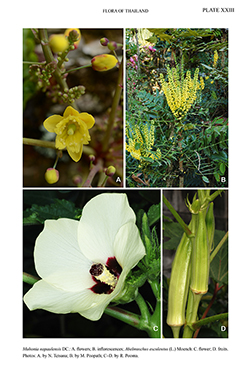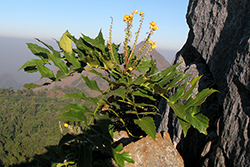e-Flora of Thailand
Volume 14 > Part 2 > Year 2019 > Page 253 > Berberidaceae > Mahonia
Mahonia napaulensis DC.wfo-0001257901
Syst. Nat. 2: 21. 1821; Fedde in Engl., Bot. Jahrb. Syst. 31: 120, fig. 3 C. 1901; Craib, Bull. Misc. Inform. Kew 1911: 11. 1911; Aberdeen Univ. Studies 57: 10. 1912; Takeda, Notes Roy. Bot. Gard. Edinburgh 6: 216, pl. I, II, XXXIII figs. 1–5. 1917; Gagnep. in Humbert, Fl. Indo-Chine Suppl. 1: 144. 1938; Ahrendt, J. Linn. Soc., Bot. 57: 312. 1961; Grierson in Grierson & D.G.Long, Fl. Bhutan 1(2): 327, fig. 26 c, d. 1984; T.S.Ying et al. in C.Y. Wu et al., Fl. China 19: 779. 2011. Fig. 1. Plate XXIII: A–B.
Synonyms & Citations :
Description : Shrubs 1.5–4(–6) m high; bark rough, corky; wood yellow. Leaves (13–)20–70 cm long, crowded at apex of stems; petiole 1–3 cm long; leaflets 4–9 pairs, lanceolate, elliptic to ovate, (4–)5–15 by (2–)2.5–6.5 cm, variable in size per leaf, usually increasing from the basal pairs to the middle and then decreasing towards the apex; basal pair smallest, (1–)4–5 by (0.7–)2–3 cm; blade thick coriaceous, rigid, glabrous, more or less glossy on the upper surface; base broadly cuneate, rounded, subcordate to truncate, oblique; apex acute with sharp spine; margin coarsely sharply spiny, with 3–5(–7) teeth on each side; primary veins 3–5(–8), arising from the base, usually 3 prominent; lateral leaflets sessile; terminal leaflets with petiolules up to 3 cm long or sometimes sessile. Inflorescences in fascicles of 6–10 racemes, 10–20(–47) cm long; pedicels 3–6(–15) mm long, glabrous; bracts lanceolate to ovate, 3–5 mm long, subtending each flower; sepals 9, in 3 series, ovate to obovate, broadly acute to obtuse or rounded at apex, glabrous; outermost sepals smallest, 2.5–3 by 2–2.5 mm; middle sepals smaller than or subequal to innermost sepals, 4.5–8 by 3–4.5 mm; petals 6, in 2 series, subequal, 4.5–8 by 3–4.5 mm, apex bilobed or emarginate; filaments flattened, 3.5–4.5 mm long, glabrous; ovary narrowly ellipsoidal, 3.5–4 mm long, glabrous; style 1.5–3 mm long; stigma capitate-peltate. Berries ellipsoid to subglobose, 5–8(–10) mm long, bluish black, glaucous, with persistent style at apex. Seeds 2–5(–7), ellipsoid, curved, 4–5 mm long.
Thailand : NORTHERN: Mae Hong Son (Doi Chong, Huai Phu Loei), Chiang Mai (Doi Suthep-Pui NP – type of Mahonia siamensis Takeda: Kerr 1107A -BM K; Doi Inthanon NP, Doi Chiang Dao WS, Doi Sam Muen, Mae Chaem, Wat Chan), Phayao (Doi Luang NP), Nan (Doi Phu Wae).
Distribution : India, Nepal, Bhutan, S China, Myanmar, Vietnam.
Ecology : Hill evergreen forests, lower montane scrub, open areas on limestone mountains, 1,200–2,100 m alt. Flowering: (November–)January–April; fruiting: April–June (–October).
Vernacular : Khamin ton (ขมิ้นต้น).
Uses: Heartwood is used for the relieve of stomachache and as anti-diarrhoeic.
Notes: Mahonia siamensis Takeda was placed in the synonymy of M. duclouxiana Gagnep. by Ying et al. (2011). However, an examination of the material collected in Thailand, showed it to be variable and closely resembling M. napaulensis DC. The differences can only be found in relative sizes of leaflets and flower parts. Therefore, the species is placed in the synonymy of M. napaulensis.
E-version notes : Berberis napaulensis (DC.) Spreng.
Syst. Veg., ed. 16, 2: 120. 1825, as ‘Berberis nepalensis’; Hook.f. & Thomson in Hook.f., Fl. Brit. India 1: 109. 1872; Kurz, Forest Fl. Burma 1: 58. 1877; Laferr., Bot. Zhurn. (Moscow & Leningrad) 82(9): 98. 1997 (as new combination, did not recognize incorrect spelling of Sprengel, 1825).




